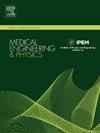Benchmarking 2D human pose estimators and trackers for workflow analysis in the cardiac catheterization laboratory
IF 1.7
4区 医学
Q3 ENGINEERING, BIOMEDICAL
引用次数: 0
Abstract
Workflow insights can improve efficiency and safety in the Cardiac Catheterization Laboratory (Cath Lab). As manual analysis is labor-intensive, we aim for automation through camera monitoring. Literature shows that human poses are indicative of activities and therefore workflow. As a first exploration, we evaluate how marker-less multi-human pose estimators perform in the Cath Lab. We annotated poses in 2040 frames from ten multi-view coronary angiogram (CAG) recordings. Pose estimators AlphaPose, OpenPifPaf and OpenPose were run on the footage. Detection and tracking were evaluated separately for the Head, Arms, and Legs with Average Precision (AP), head-guided Percentage of Correct Keypoints (PCKh), Association Accuracy (AA), and Higher-Order Tracking Accuracy (HOTA). We give qualitative examples of results for situations common in the Cath Lab, with reflections in the monitor or occlusion of personnel. AlphaPose performed best on most mean Full-pose metrics with an AP from 0.56 to 0.82, AA from 0.55 to 0.71, and HOTA from 0.58 to 0.73. On PCKh OpenPifPaf scored highest, from 0.53 to 0.64. Arms, Legs, and the Head were detected best in that order, from the views which see the least occlusion. During tracking in the Cath Lab, AlphaPose tended to swap identities and OpenPifPaf merged different individuals. Results suggest that AlphaPose yields the most accurate confidence scores and limbs, and OpenPifPaf more accurate keypoint locations in the Cath Lab. Occlusions and reflection complicate pose tracking. The AP of up to 0.82 suggests that AlphaPose is a suitable pose detector for workflow analysis in the Cath Lab, whereas its HOTA of up to 0.73 here calls for another tracking solution.
基准二维人体姿态估计器和跟踪器的工作流程分析在心导管实验室
工作流程洞察可以提高心导管实验室(Cath Lab)的效率和安全性。由于人工分析是劳动密集型的,我们的目标是通过摄像头监控实现自动化。文献表明,人的姿势是活动的指示,因此是工作流程。作为第一个探索,我们评估了无标记的多人体姿势估计器在Cath实验室中的表现。我们从10个多视角冠状动脉造影(CAG)记录中标注了2040帧的姿势。姿态估计器AlphaPose, OpenPifPaf和OpenPose在镜头上运行。分别对头部、手臂和腿部的检测和跟踪进行平均精度(AP)、头部引导的正确关键点百分比(PCKh)、关联精度(AA)和高阶跟踪精度(HOTA)的评估。我们给出了在Cath实验室常见情况下的定性结果示例,并反映在监视器或人员遮挡中。AlphaPose在大多数平均全姿态指标上表现最好,AP从0.56到0.82,AA从0.55到0.71,HOTA从0.58到0.73。在PCKh上,OpenPifPaf得分最高,为0.53 ~ 0.64。从遮挡最少的视图来看,手臂、腿和头部按这个顺序被检测得最好。在Cath实验室的跟踪过程中,AlphaPose倾向于交换身份,而OpenPifPaf则合并了不同的个体。结果表明,在Cath实验室中,AlphaPose产生最准确的置信度评分和肢体,而OpenPifPaf产生更准确的关键点位置。遮挡和反射使姿态跟踪复杂化。高达0.82的AP表明AlphaPose是一个适合Cath实验室工作流程分析的姿势检测器,而高达0.73的HOTA则需要另一种跟踪解决方案。
本文章由计算机程序翻译,如有差异,请以英文原文为准。
求助全文
约1分钟内获得全文
求助全文
来源期刊

Medical Engineering & Physics
工程技术-工程:生物医学
CiteScore
4.30
自引率
4.50%
发文量
172
审稿时长
3.0 months
期刊介绍:
Medical Engineering & Physics provides a forum for the publication of the latest developments in biomedical engineering, and reflects the essential multidisciplinary nature of the subject. The journal publishes in-depth critical reviews, scientific papers and technical notes. Our focus encompasses the application of the basic principles of physics and engineering to the development of medical devices and technology, with the ultimate aim of producing improvements in the quality of health care.Topics covered include biomechanics, biomaterials, mechanobiology, rehabilitation engineering, biomedical signal processing and medical device development. Medical Engineering & Physics aims to keep both engineers and clinicians abreast of the latest applications of technology to health care.
 求助内容:
求助内容: 应助结果提醒方式:
应助结果提醒方式:


